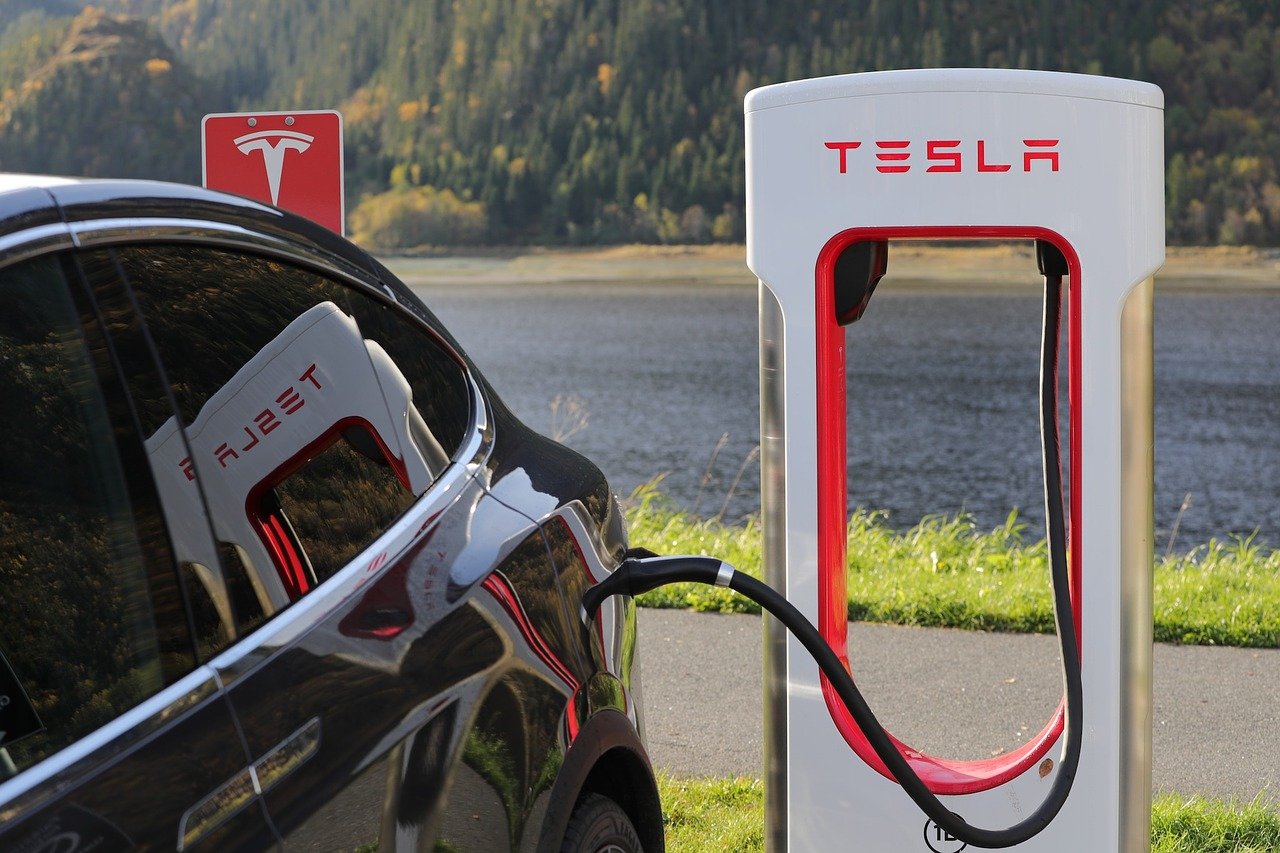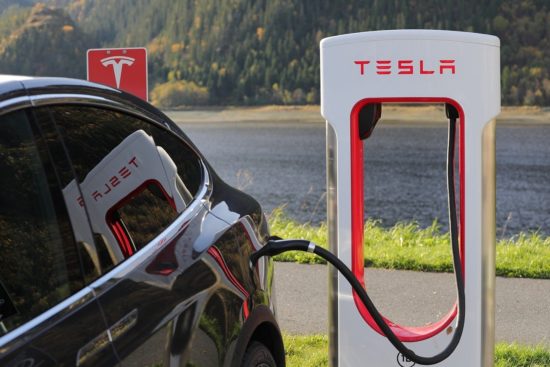Tesla Wins Another Round.
by Wallace Wyss –
This battle never was of forces evenly matched. Tesla started out almost in somebody’s garage like Apple, but they always had a different mission–to electrify the automobile industry.
Detroit automakers dragged their heels, first GM unveiling the EV1 (even before Tesla started) but envisioning EVs as a distant other choice, hoping instead you’ll come to your senses, and go for their latest ICE offering and maybe be moved to purchase by a new hood scoop or tailfins. Lay on the chrome they always go for Glitz.
I could even blame some of this on Harley Earl, GM’s first head of styling, who perfected the mantra of making consumers think– if you wanted to be seen as a winner–you had to have the latest body style. Now GM and Ford have agreed to change their EV charging cables in future year models to be able to use Tesla’s 12,000 strong charging stations. What this will do is make money for Tesla–they will charge a premium for ‘outsiders’ to charge at a Tesla charger.
And help Tesla sales as owners of Detroit EVs will see Teslas up close for the first time and hear from owners. Tesla owners won’t be too happy, though, when they have to wait in line for a charger but no doubt Musk will just add another 6000 chargers to his network.
The key thing is this is a psychological victory. Tesla was slammed by Detroiters like ex-GM honcho Bob Lutz but now, in a mere 20-day stretch, Tesla stock climbed in value equal to that of Ford and GM combined. The Detroit automaker execs who saw fighting Tesla as the only way to go are eating their own words now.
But hey, Elon, let’s compromise, give us a little Harley, say stainless steel roofs, and brocade interiors and “Dagmar” bumper guards (I could describe how they got their nickname but that wouldn’t be politically correct…)
Let us know what you think in the Comments.
THE AUTHOR: Wallace Wyss is the author of 18 car histories. As a fine artist, he is presently doing oil portraits of classic cars on commission. He can be reached at malibucarart@gmail.com





Hey Wyss…. I am SO glad you are now seeing a positive side to Elon and Tesla….and maybe EVs?
There is NO energy for air conditiong, fridges AND electrical cars charged by public grid. Other solution MUST be developed and introduced at DECENT preices.
Juvinile, we are on the cusp of fusion generated energy, no waste, no exhaust, electrical generation by fusion replicates the sun, producing unlimited electrical energy. Wise up… https://www.goodnewsnetwork.org/nuclear-fusion-reactor-hotter-than-the-sun-to-provide-unlimited-clean-energy-to-the-world/ If you were around in 1890, you would piss on gasoline cars, as there were no gas stations, no dealerships for the piston cars, and no mechanics, and no auto parts stores… you would say “Lets keep riding horses” as there are not enough resources for piston cars.
YOU are the reason why things stagnate. Resources will grow as needed for our transportation. Even if it is electric.
By the way, if you have a chance look these up on google: Refinery explosion photos, Exxon Valdez oil spill photos, and Gulf oil disaster photos.
You will still need an infrastructure to deliver this electricity and that is not in place at all. Until electricity can be generated at your own home, which is unpractical for most apartment owners, you are now at the mercy of waiting for access to charging stations. That will only get much, much worse with gov’t mandates on EV sales. It doesn’t matter what fancy generating plant is built in another location if it can’t get to you when you need it. Imagine long lines or appointments to get your car charged. EVs still have too many limitations and one being the ability to shut them off remotely with the stroke of a keyboard. So if you aren’t complying to the latest governmental decree, your freedom of movement will be eliminated. No charging station for you and your car becomes a boat anchor. Sitting in your car bombarding yourself with high levels of EMFs and also more of the same around charging stations will reduce your health just as much as any ICE car would.
There is an even bigger infrastructure boondoggle right now. It starts in Iran (building atomic bombs for terrorists with oil money) and Saudi Arabia, (didn’t Saudis fly planes into the World Trade Center buildings?) That tainted oil at high cost goes onto tankers, spewing bunker fuel particles halfway around the world, or more, if the tankers hold up and do not go aground, (see Exxon Valdez oil spill photos) Then, the oil is sent to your local refinery, which makes the area around the refinery into a “Cancer cluster” for the folks living around it.. and don’t forget about the Gulf Oil spill disaster. 11 people were killed and millions of birds, animals and fish were killed. Look up some of those photos.
Now, besides the new fusion reactors, there has been a resurgence to thermal generation of electricity..
SO ironic… fracking has made Geothermal more of a reality, like in Iceland, where they have geothermal
electricity generation and an excess of Hydrogen made from that electricity.
https://open.substack.com/pub/davidroberts/p/enhanced-geothermal-power-is-finally?r=428s3&utm_campaign=post&utm_medium=email
Isn’t the core of the earth still molten hot? There have been some active volcanoes recently, spewing
red hot lava….. lets harness some of this heat energy to make steam, turn turbines and make some
electricity to help run things for our lives that run on electricity……
So, in the near future, we just might have plenty of fusion and Geothermal electricity without killing
people, birds, fish and animals with oil and its pollution… I think we can dig up and plug in some wires…
Brian,
Producing and supporting the “fuel”, electricity in this case; is one battle. But perhaps the worst is storing it (batteries in this case). This is where the real problem is being ignored; raping the earth, child labor, toxic wastes, etc…. Electricity is NOT the way for personal transportation. Get you head out of the sand.
What is a battery?’ I think Tesla said it best when they called it an Energy Storage System. That’s important.
They do not make electricity – theystore electricity produced elsewhere, primarily by coal, uranium, natural gas-powered plants, diesel-fueled generators or minerals. So, to say an Electric Vehicle (EV) is a zero-emission vehicle is not at all valid.
Also, since forty percent of the electricity generated in the U.S. is from coal-fired plants, it follows thatforty percent of the EVs on the road are coal-powered, do you see? If not, read on.
Einstein’s formula, E=MC2, tells us it takes the same amount of energy to move a five-thousand-pound gasoline-driven automobile a mile as it does an electric one. The only question again is what produces the power? To reiterate, it does not come from the battery; the battery is only the storage device, like a gas tank in a car.
There are two orders of batteries, rechargeable, and single-use. The most common single-use batteries are A, AA, AAA, C, D. 9V, and lantern types. Those dry-cell species use zinc, manganese, lithium, silver oxide, or zinc and carbon to store electricity chemically. Please note they all contain toxic, heavy metals.
Rechargeable batteries only differ in their internal materials, usually lithium-ion, nickel-metal oxide, and nickel-cadmium. The United States uses three billion of these two battery types a year, and most are not recycled; they end up in landfills. California is the only state which requires all batteries be recycled. If you throw your small, used batteries in the trash, here is what happens to them.
All batteries are self-discharging. That means even when not in use, they leak tiny amounts of energy. You have likely ruined a flashlight or two from an old, ruptured battery. When a battery runs down and can no longer power a toy or light, you think of it as dead; well, it is not. It continues to leak small amounts of electricity. As the chemicals inside it run out, pressure builds inside the battery’s metal casing, and eventually, it cracks. The metals left inside then ooze out. The ooze in your ruined flashlight is toxic, and so is the ooze that will inevitably leak from every battery in a landfill. All batteries eventually rupture; it just takes rechargeable batteries longer to end up in the landfill.
In addition to dry cell batteries, there are also wet cell ones used in automobiles, boats, and motorcycles. The good thing about those is, ninety percent of them are recycled. Unfortunately, we do not yet know how to recycle single-use ones properly.
But that is not half of it. For those of you excited about electric cars and a green revolution, I want you to take a closer look at batteries and also windmills and solar panels. These three technologies share what we call environmentally destructive embedded costs.
Everything manufactured has two costs associated with it, embedded costs and operating costs. I will explain embedded costs using a can of baked beans as my subject.
In this scenario, baked beans are on sale, so you jump in your car and head for the grocery store. Sure enough, there they are on the shelf for $1.75 a can. As you head to the checkout, you begin to think about the embedded costs in the can of beans.
The first cost is the diesel fuel the farmer used to plow the field, till the ground, harvest the beans, and transport them to the food processor. Not only is his diesel fuel an embedded cost, so are the costs to build the tractors, combines, and trucks. In addition, the farmer might use a nitrogen fertilizer made from natural gas.
Next is the energy costs of cooking the beans, heating the building, transporting the workers, and paying for the vast amounts of electricity used to run the plant. The steel can holding the beans is also an embedded cost. Making the steel can requires mining taconite, shipping it by boat, extracting the iron, placing it in a coal-fired blast furnace, and adding carbon. Then it’s back on another truck to take the beans to the grocery store. Finally, add in the cost of the gasoline for your car.
A typical EV battery weighs one thousand pounds, about the size of a travel trunk. It contains twenty-five pounds of lithium, sixty pounds of nickel, 44 pounds of manganese, 30 pounds cobalt, 200 pounds of copper, and 400 pounds of aluminum, steel, and plastic. Inside are over 6,000 individual lithium-ion cells.
It should concern you that all those toxic components come from mining. For instance, to manufacture each EV auto battery, you must process 25,000 pounds of brine for the lithium, 30,000 pounds of ore for the cobalt, 5,000 pounds of ore for the nickel, and 25,000 pounds of ore for copper. All told, you dig up 500,000 pounds of the earth’s crust for just one battery.”
Sixty-eight percent of the world’s cobalt, a significant part of a battery, comes from the Congo. Their mines have no pollution controls, and they employ children who die from handling this toxic material. Should we factor in these diseased kids as part of the cost of driving an electric car?” And the Chinese just bought most of these mines!
I’d like to leave you with these thoughts. California is building the largest battery in the world near San Francisco, and they intend to power it from solar panels and windmills. They claim this is the ultimate in being ‘green,’ but it is not! This construction project is creating an environmental disaster. Let me tell you why.
The main problem with solar arrays is the chemicals needed to process silicate into the silicon used in the panels. To make pure enough silicon requires processing it with hydrochloric acid, sulfuric acid, nitric acid, hydrogen fluoride, trichloroethane, and acetone. In addition, they also need gallium, arsenide, copper-indium-gallium- diselenide, and cadmium-telluride, which also are highly toxic. Silicone dust is a hazard to the workers, and the panels cannot be recycled.
Windmills are the ultimate in embedded costs and environmental destruction. Each weighs 1688 tons (the equivalent of 23 houses) and contains 1300 tons of concrete, 295 tons of steel, 48 tons of iron, 24 tons of fiberglass, and the hard to extract rare earths neodymium, praseodymium, and dysprosium. Each blade weighs 81,000 pounds and will last 15 to 20 years, at which time it must be replaced. We cannot recycle used blades. Sadly, both solar arrays and windmills kill birds, bats, sea life, and migratory insects.
There may be a place for these technologies, but you must look beyond the myth of zero emissions. I predict EVs and windmills will be abandoned once the embedded environmental costs of making and replacing them become apparent. “Going Green” may sound like the Utopian ideal and are easily espoused, catchy buzzwords, but when you look at the hidden and embedded costs realistically with an open mind, you can see that Going Green is more destructive to the Earth’s environment than meets the eye, for sure.
If this had been titled… “The Embedded Costs of Going Green,” would you have read it? Please share if you wish. Wonder what the real reason for the Going Green campaign is?
One issue you mention is just hitting the headlines–the weight of batteries increasing the weight of cars. The average car now weighs over 3000 lbs. The battery in the Hummer EV weighs more than 2,000 lbs. just by itself, the entire vehicle over 7,000 lbs. So the issue is the increased weight of EVs makes them more deadly in a crash with a lighter car. I view this argument skeptically because if they were against heavier vehicles why can’t the safety nuts protest against the takeover of the pickup truck market by oversize pickup trucks ()most of which I see with the loadbeds empty) because they pose a danger to smaller car drivers too. Look at that Smart car, complete flop that wouldn’t stand a chance against a 5,000 lb. pickup. We in America can’t go to smaller cars than we are used to because they are up against mastodons in crashes. Might as well throw in a couple coffins with each sub-2,000 lbs. microcar,you’re gonna need it.
Fred, if a long rant makes you right, you are right as rain. Did you realize that upcoming Hydrogen is a way to store electricity,… NO you did not. Iceland has an excess of Hydrogen made for free, using their thermal energy. Water thru pipes in the thermal generation areas, makes steam, turning generators to make electricity to electrolize water into Hydrogen. I leased a Hydrogen fuel cell Honda Clarity for 3 years, no heavy battery. No oil changes, smog checks, no cams going flat, no rods coming apart and going thru the block, no lifters that click and go flat, no broken timing chains, no valve jobs, no fuel pumps that quit supplying fuel, no destroyed bearings going clunk clunk clunk, no broken piston rings making smoke like mosquito abatement, no rusting out of exhaust pipes, no cracked exhaust manifolds, no malfunctioning carburetors, no leaking water pumps, no clogged injectors, no dead starters, no dead alternators, no cracked pistons, no tune ups, no fouled spark plugs, no clogged catalytic converters, no stolen catalytic converters, no rusted out mufflers, no coolant changes, no heater cores leaking stinky “anti freeze coolant” into the passenger compartment, and tell me how a cast iron engine is “Lightweight” . Did you realize that the combustion residue in a piston engine goes into the engine oil, that is why it turns black, and those dirt and combustion residues wear out the piston engine? The engine wears itself out. Did you realize an electric motor has ONE moving part, and all the companies are knocking on the door of ONE MILLION mile electric motors. Battery materials have changed, and will continue to change. When I was a kid in the 50s, alkaline batteries leaked and ruined half the devices they were installed in… junk… next were Nicad batteries, then nickel metal hydride batteries, then Lithium Ion batteries. Notice that battery material keeps changing, to make them safer, lighter, more energy dense, faster charging and longer range.. Toyota is working on 900 mile range breakthrough batteries. Note that the smoking, clunking, extremely unreliable cars from the 1890s were still equipped with pistons jumping up and down. (The SAME as the current internal combustion cars that you are buying today) Batteries are being recycled by Redwood, for most major manufacturers, and stop with the coal bs…. Fusion is coming to the world soon, and will be the worlds fuel source, not digging old Dino Pee out of the ground in Saudi Arabia or Iran and shipping it all over the world in Bunker Fuel spewing and oil spilling tankers… again, Google: Refinery Explosion Photos, Exxon Valdez oil spill photos, and Gulf oil spill disaster photos. This is America, and Americans buy what they want. Some may want to buy an EV, or Hydrogen car because of the reasons mentioned above… Lets have a choice…don’t count out an EV or H2 because of existing conditions….. things change……………… constantly …….
Mine is not merely a rant. Hydrogen may be fine, but the current batteries (pun intended) are not. That is all I’m saying.